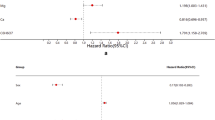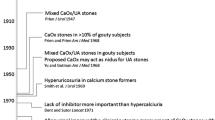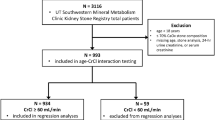Abstract
Different mathematical expressions have been proposed in the literature with the aim to reflect the risk of calcium oxalate urolithiasis. Such expressions, as well as a number of new relationships proposed by us, have been evaluated in 76 patients and 34 normal subjects. Stone-formers were divided into two groups: patients with normal calcium and oxalate excretion and patients with hypercalciuria and/or hyperoxaluria. The results obtained were comparatively evaluated. Several formulae gave some acceptable results, but none of them were excellent. This can be explained by the fact that these discrimination indexes more or less reflect supersaturation and/or inhibition deficit, but none of them reflect promoting factors such as heterogeneous nucleation and/or aggregation capacity.
Similar content being viewed by others
References
Robertson, W. G.: Physical chemical aspects of calcium stone-formation in urinary tract. In: Fleish, Robertson, Smith, Vahlensieck (eds): Urolithiasis Research. Plenum Press, New York 1976, pp. 25–39.
Robertson, G. W., Peacock, H., Marshall, R. W., Marshall, D. H., Nordin, B. E. C.: Saturation inhibition index as a measure of the risk of calcium oxalate stone formation in the urinary tract.N. Engl. J. Med., 294, 249 (1976).
Tiselius, H. G.: Different estimates of the risk of calcium oxalate crystallization in urine.Eur. Urol., 9, 231 (1983).
Tiselius, H. G.: An improved method for the routine biochemical evaluation of patients with recurrent calcium oxalate stone disease.Clin. Chim. Acta, 122, 409 (1982).
Robertson, W. G., Peacock, H., Heyburn, P. J., Marshall, D. H., Clark, P. B.: Risk factors in calcium stone disease of the urinary tract.Br. J. Urol., 50, 449 (1978).
Hodgkinson, A.: Relations between oxalic acid, calcium, magnesium and creatinine excretion in normal men and male patients with calcium oxalate kidney stones.Clin. Sci. Mol. Med., 46, 357 (1974).
Finlayson, B.: Calcium stones: some physical and clinical aspects. In: David (ed.): Calcium Metabolism in Renal Failure and Nephrolithiasis. Wiley, New York 1977, pp. 337–382.
Thiselius, H. G., Larson, L.: Biochemical evaluation of patients with urolithiasis.Eur. Urol., 7, 31 (1981).
Tiselius, H. G., Almgard, L. E., Larson, L., Sorbo, B.: A biochemical basis for grouping of patients with urolithiasis.Eur. Urol., 4, 241 (1978).
King, J. S. Jr., O’Connor, F. J. Jr., Smith, M. J. V., Crouse, L.: The urinary calcium/magnesium ratio in calcigerous stone formers.Invest. Urol., 6, 60 (1968).
Takasaki, E.: Urinary magnesium and oxalic acid excretion in patients with recurrent oxalate urolithiasis.Invest. Urol., 12, 251 (1975).
Yendt, E. R., Cohanim, M.: 10 years experience with the use of thiazides in the prevention of kidney stones.Trans. Am. Clin. Climatol. Assoc., 85, 65 (1973).
Oreopoulus, D. G., Souannwo, M. A. O., McGeown, M. G.: Magnesium/calcium ratio in urine of patients with renal stones.Lancet, ii, 420 (1968).
Parks, J. H., Coe, F. L.: A urinary calcium-citrate index for the evaluation of nephrolithiasis.Kidney Int., 30, 85 (1986).
Butz, M., Knispel, H.: Molar calcium citrate ratio as diagnostic indicator in calcium nephrolithiasis. In: R. Ryall, J. G. Brocks, V. Marshall B. Finlayson (eds): Urinary Stone. Churchill Livingstone, New York 1984.
Welshman, S. G., McCambridge, H.: The estimation of citrate in serum and urine using citrate lyase technique.Clin. Chim. Acta, 46, 243 (1973).
Cannon, G. D., Eaton, R. H., Glen, A. C. A., Moncur, J.: Enzymic determination of urinary oxalate, with EDTA added to improve recovery.Clin. Chem., 29, 1855 (1983).
Robertson, W. G., Peacock, M., Nordin, B. E. C.: Activity products in stone-forming and non stone-forming urine.Clin. Sci., 32, 579 (1968).
Robertson, W. G., Peacock, M., Nordin, B. E. C.: Calcium oxalate crystalluria and urine saturation in current renal stone-formers.Clin. Sci., 40, 365 (1971).
Marshall, R. W., Barry, H.: Urine Saturation and Formation of Calcium Containing Calculi: The Effects of Various Forms of Therapy. Karger, Basel 1973.
Grases, F., Genestar, C., March, J., Conte, A.: Variation in the activity of urinary inhibitors in calcium oxalate urolithiasis.Br. J. Urol. (in press).
Author information
Authors and Affiliations
Rights and permissions
About this article
Cite this article
Roca, P., Conte, A., Riera, T. et al. Can a relationship reflect the risk of calcium oxalate urolithiasis?. International Urology and Nephrology 22, 215–222 (1990). https://doi.org/10.1007/BF02550395
Received:
Issue Date:
DOI: https://doi.org/10.1007/BF02550395




